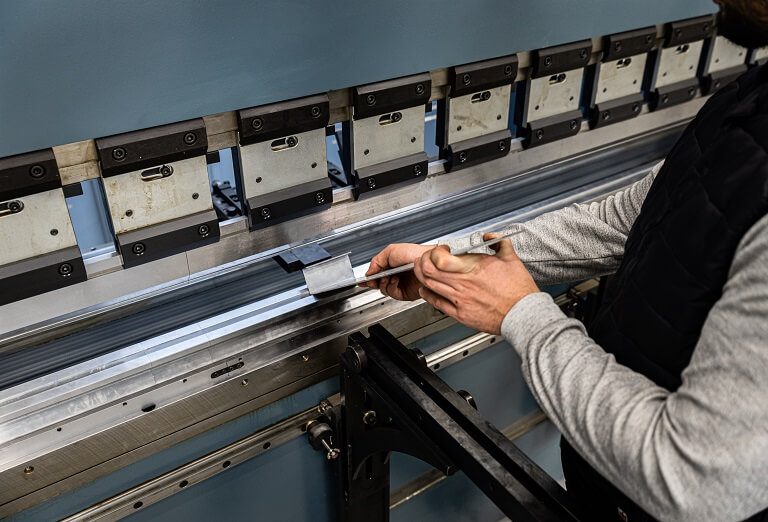
Sheet metal bending stands as a fundamental process in the manufacturing realm, serving as the backbone for crafting intricate and tailored components across various industries. While this method enables precision and versatility, the challenge lies in minimizing material waste to enhance operational efficiency, curtail costs, and foster environmental sustainability.
In a global manufacturing landscape where competitiveness and sustainability are paramount, adopting strategies to reduce material waste in sheet metal bending becomes crucial. This blog explores the intricacies of sheet metal bending, delves into the factors contributing to material waste, and outlines strategies, technologies, and real-world case studies that facilitate waste reduction and operational efficiency.
Understanding Sheet Metal Bending:
Sheet metal bending involves the manipulation of metal sheets to achieve specific shapes and forms. Despite its prevalence, the process poses challenges that often result in material wastage. From imprecise measurements to inefficient workflows, understanding the basics and challenges is vital for implementing effective waste reduction strategies.
Factors Contributing to Material Waste:
Inaccurate Measurements and Design Errors:
- Accurate measurements are the cornerstone of successful sheet metal bending.
- Design errors can lead to costly rework and increased scrap rates, emphasizing the need for precision in the initial stages.
Suboptimal Tooling and Equipment:
- Selecting the right tools for specific bends ensures efficiency and reduces material waste.
- Regular maintenance of equipment is essential to prevent breakdowns and maintain optimal performance
Inefficient Process Planning and Workflow:
- Streamlining production processes minimizes idle time and reduces material waste.
- Just-in-time manufacturing principles help avoid excess inventory, mitigating waste and optimizing resource utilization.
Lack of Employee Training and Skill Development:
- Skilled operators are key to minimizing errors and reducing material waste.
- Continuous training programs keep employees updated on the latest techniques and technologies, fostering a culture of continuous improvement.
Strategies for Minimizing Material Waste:
Precision in Measurement and Design:
- Advanced design software aids in achieving precise measurements, reducing the margin for error.
- Emphasize the role of detailed planning and prototyping to catch design flaws early in the process.
Optimal Tooling and Equipment Selection:
- Choosing the right tools involves considering material properties and bend requirements.
- Regular equipment checks and preventive maintenance schedules ensure longevity and consistent performance.
Efficient Process Planning and Workflow:
- Implementing lean manufacturing principles optimizes workflows, reducing material handling and transportation waste.
- Integrating digital tools for production scheduling and monitoring enhances real-time visibility, allowing for quick adjustments.
Employee Training and Skill Development:
- Establish comprehensive training programs covering both traditional and advanced techniques.
- Foster a culture of continuous learning, encouraging employees to stay abreast of industry developments and technological advancements.
Advanced Technologies in Sheet Metal Bending:
Computer Numerical Control (CNC) Technology:
- CNC technology enhances precision by allowing for automated and programmable bending processes.
- Discuss the cost-efficiency and waste reduction achieved through CNC-controlled operations.
Artificial Intelligence and Machine Learning Applications:
- AI and ML applications analyze data to optimize bending parameters, reducing trial-and-error waste.
- Discuss predictive maintenance models that minimize equipment downtime and material waste.
Robotics in Sheet Metal Fabrication:
- Robotics automates repetitive tasks, enhancing efficiency and minimizing errors.
- Explore examples of robotic arms performing complex bends with precision, reducing material waste associated with human error.
Environmental and Economic Benefits:
Reduced Environmental Impact:
- Quantify the environmental impact of material waste in sheet metal bending.
- Discuss how waste reduction aligns with sustainability goals, emphasizing the importance of eco-friendly manufacturing practices.
Cost Savings and Improved Profitability:
- Break down the economic benefits of waste reduction, including reduced raw material costs and lower disposal expenses.
- Share a case study illustrating how a company’s commitment to waste reduction led to increased profitability.
Enhanced Competitiveness in the Market:
- Explore how adopting sustainable practices, including waste reduction, enhances a company’s market position.
- Discuss how environmentally conscious consumers and regulatory trends contribute to the importance of sustainability in manufacturing.
Challenges and Considerations:
Potential Challenges in Implementation:
- Outline common challenges companies may face when implementing waste reduction strategies.
- Provide practical solutions and best practices to overcome these challenges.
Balancing Efficiency with Quality:
- Emphasize the importance of maintaining high product quality while pursuing operational efficiency.
- Discuss how technological advancements contribute to achieving a balance between speed and precision in sheet metal bending.
Future Trends in Sheet Metal Bending:
Emerging Technologies and Their Impact:
- Explore upcoming technologies such as 3D metal printing and their potential impact on sheet metal bending.
- Discuss how these technologies may redefine traditional processes and contribute to further waste reduction.
Sustainable Practices and Circular Economy Approaches:
- Introduce the concept of a circular economy in sheet metal bending, emphasizing recycling and material reuse.
- Discuss industry initiatives and collaborations promoting sustainable practices within the manufacturing sector.
Conclusion:
In summary, the efficient reduction of material waste in sheet metal bending is a multifaceted endeavor requiring precision, technological integration, and a commitment to continuous improvement. By addressing key factors contributing to waste, implementing advanced technologies, and embracing sustainable practices, manufacturers can not only enhance operational efficiency and profitability but also contribute to a greener and more sustainable future.
Related Post:
- Tool Mastery: How Expertise with Your Equipment Impacts Sheet Metal Results
- Sheet Metal Bending in Architectural Design: Transforming Buildings with Curved Metal
- How to Optimize Your Metal Fabrication Workflow
- Why Every Automotive Fabricator Needs an English Wheel: Benefits, Tips, and Safety Precautions
- Auto Body Fabrication Process and Challenges
